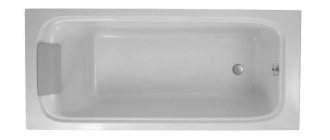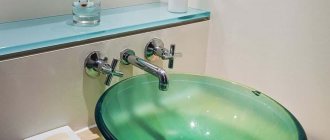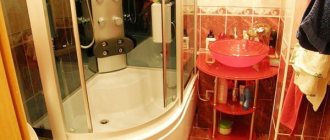Bathroom equipment should be functional, durable and aesthetically pleasing. Natural stone products meet these requirements. What is attractive about the material, what advantages and disadvantages does it have?
In our article, a stone sink is presented in a variety of popular options among users. Products from different species used in the manufacture of plumbing fixtures for many centuries are described in detail. Installation instructions and useful recommendations are provided.
Features of artificial stone sinks
Faux acrylic sink
An artificial stone sink for your bathroom will help you create an original design. This piece of furniture looks interesting, has different designs and is installed in every home. Unusual shells can be given any shape and color. Interior design is not limited to a modest choice of plumbing fixtures, so the owners make all their dreams of a beautiful interior come true.
Advantages and disadvantages
Recently, artificial stone has been very often used to make sinks. It is in many ways superior to other materials (metal, plastic and natural stone). Pros of installing a sink made of artificial stone:
- outwardly does not differ from natural ones, due to this they look respectable and expensive;
- durable, impossible to break off a piece or scratch the surface;
- lack of joint with a countertop or cabinet;
- has no pores - dirt, grease, dyes are not absorbed and leave no traces;
- the absence of seams, joints and rounded inner edges simplify the process of cleaning from any contamination;
- does not emit harmful substances even when heated, absolutely environmentally friendly;
- resistant to sudden temperature changes.
Many advantages make the artificial stone sink one of the most popular plumbing fixtures for the bathroom.
But this material has several important disadvantages:
- high price compared to a stamped metal sink;
- heavy weight;
- the difficulty of installing a massive product in a cramped room.
Installing a sink almost always requires several people. The heavy weight of the product and the difficult installation process require the intervention of professionals.
Despite its shortcomings, a washbasin made of artificial stone remains a popular element of bathroom decoration.
Professional cleaning products
Specialized household chemicals for stone sinks are represented by the following types of products:
- Cleaning powders with fine abrasives. They help clean stubborn stains, limescale and rust from your sink. Since the composition includes solid particles, mechanical action is undesirable. Dilute the substance into liquid gels with chlorine, apply for 2-3 minutes, and rinse gently.
- Liquid gels with chlorine. The substances remove even deep traces of lime and dark marks, additionally killing fungi and microbes. For deep disinfection, spread them out for 10-15 minutes.
- Sprays and liquids for composite materials. Actively removes most stains from stone sinks. They are applied with a soft sponge or sprayed and washed off with warm water after 2-3 minutes.
Among the popular brands selling plumbing products made from artificial and natural stone are the following:
- Domestos;
- Cillit;
- Sanfor;
- Cif;
- BioSol;
- Muscle;
- Amway;
- "Pemolux".
Recommendation! To remove infiltrated contaminants, salt from water, and restore the water-repellent properties of the surfaces of stone sinks and countertops, it is recommended to wipe the surface with a water-repellent solution once every 1-3 months.
Types of structures
Tulip design
The variety of models and the ability to order a sink according to an individual project give owners and designers room for imagination. Types of synthetic stone washbasins:
- In the form of a "tulip". Installed on the floor, has a simple design. It is a small bowl on a pedestal.
- Wall-mounted console sink. A stone bathroom sink connected to a countertop made of thick stone is a monolithic structure that combines the functions of a shelf for hygiene products and a washbasin.
- Invoices. Installed in a hole in a tabletop made of any material.
- Furniture. Attached to cabinets and cabinets.
Often a monolithic structure without seams is installed in the bathroom. This is the most hygienic and easy to clean option. The absence of connecting elements of an integrated washbasin simplifies cleaning, because it is in the seams that germs and unsightly dirt remain.
Folk remedies
You can wash your stone sink and remove most of the dirt with a soft cloth and one of the following methods:
- Lemon acid. The powder contains abrasives, so lemons cut into pieces are used. A separate slice or squeezed juice removes yellowed and rusty ones.
- Soda. Preparing the pulp is required to avoid scratching the shell. The composition does not rub in and is applied to dark spots, lime, traces of rust, washed off after 10.
- Mustard powder. The crumbly composition or paste is applied to a damp sponge, spread over the surface for several minutes, and then washed off.
- Carbonated drinks (Sprite). The heated drink removes limescale, rust and colored stains.
- Toothpaste in the form of a gel. It is used for cleaning and bleaching sinks.
The right products can be very effective, but don't rush to apply them over the entire surface. If possible, start by testing on a small, hidden surface.
Important: Do not use vinegar to clean marble.
Types of artificial stone
When choosing a stone washbasin, you need to pay attention first of all to the material from which it is made. Strength, durability and other important characteristics will depend on this. There are 4 types of synthetic stone:
- Porcelain tiles. A durable material that can retain its properties and presentable appearance for up to 100 years. It is made from a homogeneous mixture of various substances: feldspar, quartz, clay, pegmatite, kaolin and water. The homogeneous mixture is fired in a kiln, resulting in it acquiring the characteristics of stone.
- Composite The recipe for making such material is unique to each manufacturer. The washbasin consists of marble chips and a synthetic substance.
- Agglomerate. Consists of mixed chips of different types of stone (marble, granite, quartz). A small amount of glass or sand is added to the composition to improve the quality of the material. The binder is polymer resins. To create a washbasin with a surface similar to natural stone, dyes are added to the mixture. The material does not change its color, is resistant to mechanical damage, and does not absorb odors.
- Acrylic stone is similar in properties to natural stone. Products are produced by stamping or pouring into a mold.
Among the variety of materials for making stone bath sinks, each owner will be able to choose the ideal option for their apartment.
Alternative synthetic products
Before using specialized preparations, the sink is cleaned with alternative household compounds similar to industrial ones.
Laundry soap or dishwashing detergent
To clean a stone sink, follow these steps:
- Prepare a soft cloth or melamine sponge,
- soak in warm water,
- wash with soap or apply a little detergent,
- wash the sink of dishes,
- remaining dirt, wash the surface thoroughly,
- add foaming agent if necessary,
- leave for 2-3 minutes,
- rinse off any remaining foam with warm water,
- repeat the procedure if necessary.
The final mandatory step is to remove residual moisture from the sink with a soft, dry cloth or sponge.
Dishwashing Tablets
The tablets contain active, non-toxic ingredients that gently combat stubborn stains (vinegar, citric acid, baking soda and others). They are used as follows:
- Pour 3-4 tablespoons of clean warm water into a glass.
- Add 2-3 dishwasher tablets to the liquid.
- Stir until a paste forms.
- Spread the mixture evenly onto the sink.
- Leave the product on for 10-20 minutes.
- Remove any remaining product and rub with the soft side of the sponge.
This way you can wash sinks made of granite, marble and all types of artificial stone.
"Whiteness" (bleach)
To do this, follow the diagram:
- Remove all excess from the sink,
- close the drain hole,
- fill the sink with hot water,
- add a cup of bleach to the liquid, leave for 45-60 minutes,
- drain the water, if necessary, wipe the surface with detergent,
- Wipe the sink dry.
This cleaner is suitable for white or light-colored sinks to remove dark stains from tea, coffee, beets and other colored juices.
Ready-made bleach can be replaced with Belize gel (for example, from Sanfor), which is also convenient to use in hard-to-reach places on the sink and countertop.
What colors are used
Coloring with imitation of natural material
Washbasins made of artificial stone imitate the color of natural material, therefore they are available in 8-12 colors. There are plain sinks, but they are not so practical, because stains and dirt are clearly visible on a uniformly colored surface. The ideal option for a bathroom is a plumbing fixture with contrasting splashes.
Most washbasin models are made matte, but each company’s assortment includes several glossy or metallic sinks.
Remove scratches
Chips and/or small scratches on the sink can be decorated with putty designed for composite materials:
- Treat the damaged surface with sandpaper;
- fill the abrasions with putty;
- leave until completely dry;
- polish with paste.
GOI polishing paste - shine will come. Price - about 65 ₽
How to install the product correctly
Installing a sink yourself is a complex process that requires experience with plumbing. When installing a structure integrated into a countertop, it is necessary to involve several people in the work, because a monolithic product is heavy and cannot be installed independently.
Types of sinks depending on the method of attachment to the countertop:
- mortise is installed in a hole in a monolithic tabletop;
- the invoice is placed over a pre-made hole in the cabinet;
- integrated is mounted on top of cabinets, shelves or simply mounted on the wall.
Sinks installed on a support in the form of a cabinet, legs or cabinet are easy to install and do not need to be fixed. To install wall-hung sinks, there are 2 installation methods: with or without brackets.
Without bracket
The method is suitable for installing small sinks. Work order:
- At the required height, 2 points are marked at the attachment point.
- Using a drill or hammer drill, holes are made (before this, to simplify drilling, small depressions are created in the tile using a hammer and nail).
- Dowels are driven into them (for installation in the bathroom, only plastic dowels are used).
- The anchor screws are screwed in until they stop (it is necessary to select long fasteners from 50 to 120 mm).
- After installation, all fasteners are checked for reliability. They shouldn't scroll.
This installation method can only be used for installing small sinks.
bracket
When using brackets, the installation algorithm is similar to installing a sink on simple fasteners. Installation is carried out in the following order:
- A horizontal line is drawn on the wall corresponding to the top of the sink.
- The thickness of the sink is measured.
- Mark the attachment points below the line at a distance equal to the thickness of the sink.
- The brackets are mounted in the sink.
- Dowels are installed in the wall and brackets are driven in.
- The sink is being installed.
This fastening method is very reliable and suitable for installing massive sinks made of artificial stone.
Connection algorithm
After installing the washbasin, it must be connected to the water supply and sewerage system:
- Water is connected. During installation, it is necessary to ensure that the pipes do not twist.
- Connected to sewer. First, the siphon is attached to the washbasin.
- Screw a corrugated or rigid pipe to it.
- Insert the pipe into the sewer drain.
- Check the connection for leaks.
During installation, do not over-tighten the nuts - this may complicate further repairs or damage the gaskets during installation.
Tips for daily care
Regular and proper care will help to avoid deterioration in the aesthetic appeal of a black sink. It should be done daily and without the use of cleaning products containing abrasives or chemically aggressive components. Additional care recommendations:
- Do not store wet sponges and wipes on the sink. As water evaporates, it can leave unsightly stains, visible against a black background. In addition, bacteria, including pathogenic ones, multiply very quickly in a humid environment.
- Wipe the sink dry. It is recommended to wipe the bowl dry with a soft towel each time after use. If you leave the sink wet, the evaporating water will cover the surface with unsightly streaks, and as hard water evaporates, limescale will grow. For the same reason, it is necessary to ensure that the tap is tightly closed.
- Apply drain cleaner correctly. Compositions for cleaning sewer pipes necessarily contain strong chemically aggressive components that can dissolve blockages. If such a composition gets on the surface of the composite sink, a chemical reaction may begin that negatively affects the surface of the stone, up to the appearance of irremovable stains. If it is necessary to pour in the cleaning agent, this should be done very carefully, directing the stream to the center of the drain hole.
- Avoid strong impacts. The surface of the sink will most likely not be damaged, but a mark from the impact may remain in the form of particles of metal or other material.











